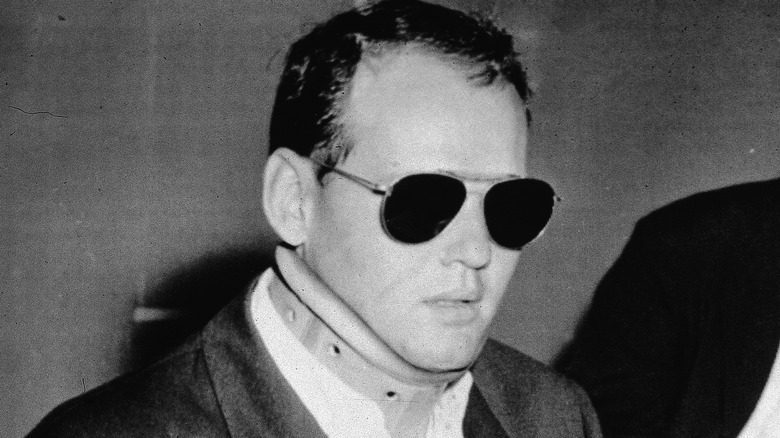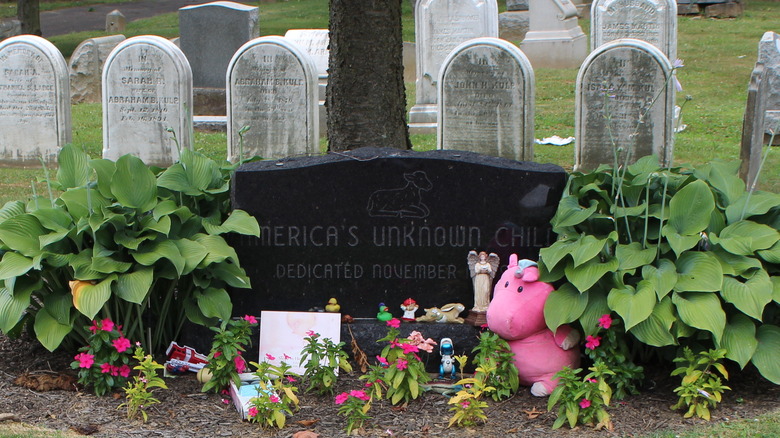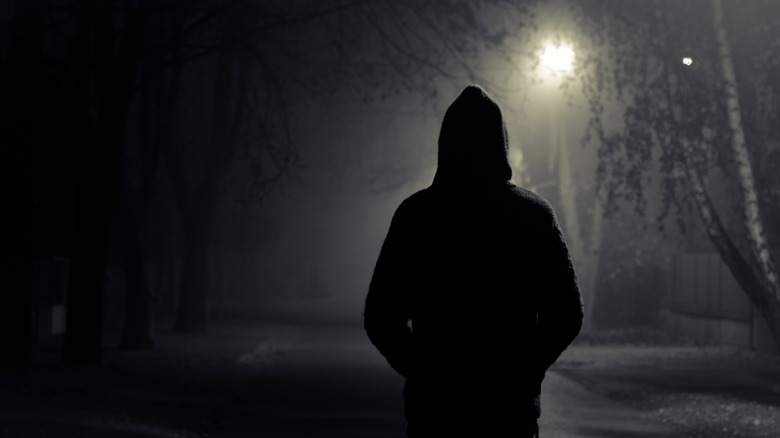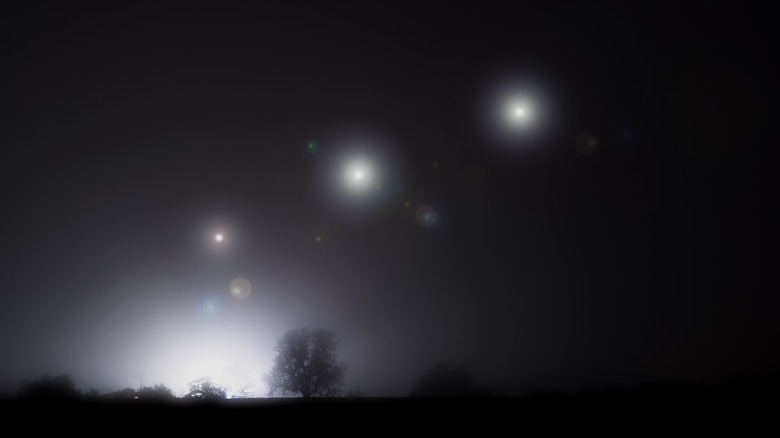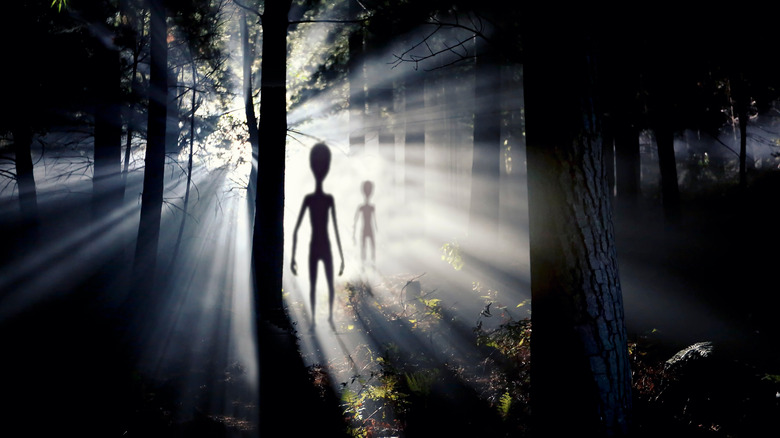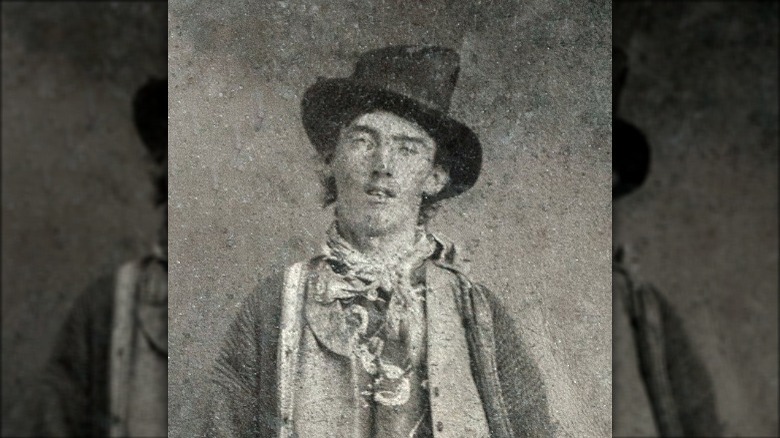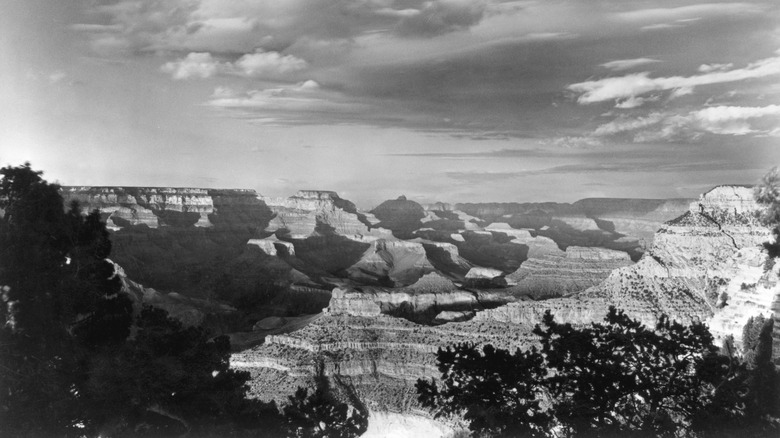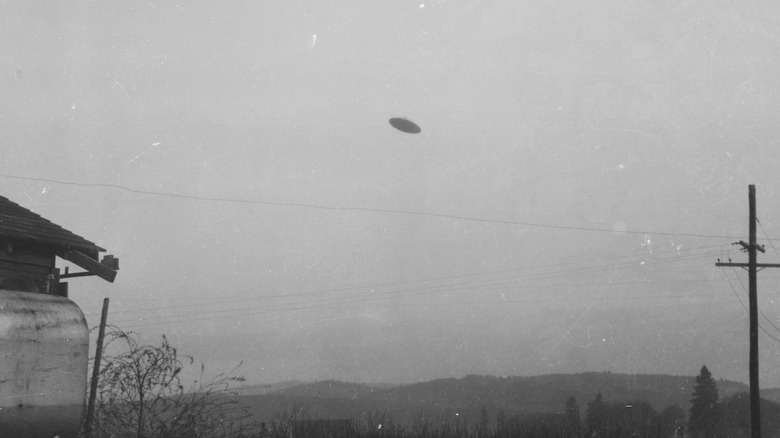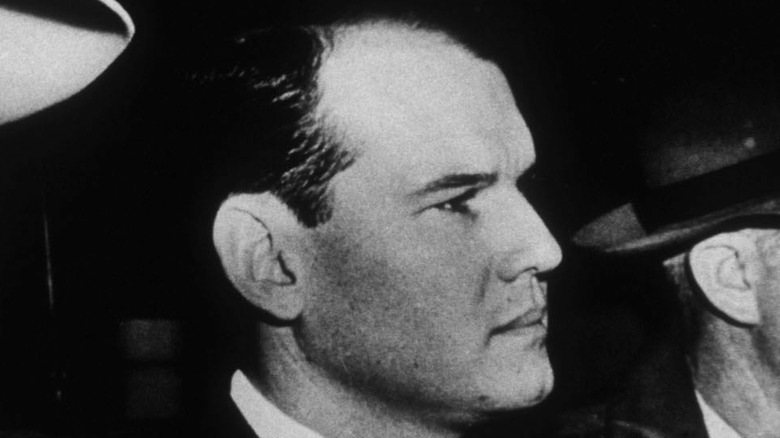Unsolved Mysteries Of 1950s America
Today, we are all used to carrying smartphones that allow for 24-hour connectivity, a wealth of knowledge at our fingertips, and a built-in camera to record any experience we find novel or unusual. But back in the '50s, the concept of "pics or it didn't happen" didn't yet exist: During this decade, many strange stories hit the headlines of local papers across the country, with no more evidence to prove they were true than the testimony of the people involved. From farmhouse battles with aliens to unsolved aviation disasters to famous Old West outlaws cheating death, the 1950s met the emerging Space Age with a hefty barrage of confounding events. Furthermore, there was little discourse on whether these stories, rumors, and legends had a grain of truth at their center, or whether they were the stuff of fantasy and delusion.
Similarly, the technological advancements seen moving into the 21st century have also aided crime prevention and investigation, while developments in the field of forensics have led to the solving of crimes that would have been unthinkable in the mid-twentieth century. However, the modern world hasn't managed to explain away every mystery of the 1950s just yet. Here are some mysteries that emerged during the 1950s, and which, even with today's technology and the benefit of hindsight, are still waiting to be solved.
The boy in the box
One of the most notorious and tragic mysteries of the 1950s was the case of the so-called "boy in the box," which unfolded in Philadelphia in 1957 with a shocking discovery. As outlined by David Stout in his 2008 book "The Boy in the Box: The Unsolved Case of America's Unknown Child," in February of that year, an 18-year-old trapper named John Stachowiak was plying his trade in an area of the city called Fox Chase, when he came across a large cardboard box.
Discarded objects were not uncommon in Fox Chase, an area where some locals used to dump garbage and unwanted possessions, according to Stout. Stachowiak was curious and peered inside the box after feeling its weight. Inside was the naked body of a young boy, who had seemingly been beaten to death.
For decades, the boy in the box remained nameless, with even the grave where his remains were interred describing him simply as "America's unknown child." For years, the case has attracted the attention of both professional and amateur investigators, all determined to uncover the boy's identity and how his body came to be abandoned. They had to wait until 2022, 65 years after the body's discovery, for a name to arrive thanks to DNA testing: Joseph Augustus Zarelli. He was from west Philadelphia and was only four years old when he died. More recently, Zarelli's parents have also been identified, but who was responsible for his tragic death remains unknown.
The bouncing ball killer
The 1970s saw a rise of serial killers with horrifying and memorable nicknames that still shiver spines today. But back in the 1950s, before this reported peak of serial killer cases, there were sensational cases that buoyed newspaper sales for years on end. One such villain was "The Bouncing Ball Killer," who terrorized Los Angeles with a spate of brutal killings beginning in May 1959, according to The Sacramento Bee.
The killer — who targeted vulnerable older women — was encountered by the roommate of his fifth victim at the scene of the crime, who told police officers and the press that he was bouncing a ball in his hand. He was so transfixed by it that at first he didn't notice the presence of the victim's roommate, but fled the scene soon afterward.
The Bouncing Ball Killer struck two more times in the Los Angeles area, before vanishing without a trace in the summer of 1960. Though one prisoner reportedly confessed to being the Bouncing Ball Killer in July 1960, the man in question was never formally charged, and the real killer has never been positively identified.
The Great Brink's Robbery's missing millions
The Great Brink's Robbery was one of the most famous crimes of the 1950s, involving an audacious movie-worthy crime, a high-profile trial, and sums of money that were unimaginable to most people at the time.
As retold in detail by the FBI, which was instrumental in solving the case, on January 17, 1950, a five-strong gang of armed men — one of whom was wearing a Captain Marvel mask as a disguise — robbed Boston's Brink's building and absconded with a grand total of $2.7 million ... around $34 million as of 2023, when adjusted for inflation. Through a large-scale investigation following hundreds of leads, the FBI eventually tracked down the 11 men they believed were responsible for planning and executing the crime.
But while many of those involved were identified, faced justice, and received fitting punishments, a huge mystery remains: What happened to the majority of the $2.7 million? Reportedly, only around $58,000 of the score was ever recovered, meaning the vast majority of it has been lost to the winds of time.
The Lubbock Lights
America's love affair with UFOs has barely wavered since the Roswell Incident of 1947, which brought to the mainstream the idea that creatures from other planets may have visited earth — as well as the compelling subtext that the U.S. government was attempting to cover their presence up. And in the 1950s, there was no shortage of sensational news stories about extraterrestrial encounters.
One of these concerned an incident on the evening of August 25, 1951, in the town of Lubbock, Texas. In this unassuming location, a group of three astronomers observing meteors claimed to have seen a large group of slow-moving blue and green lights in the sky, which flew overhead in two waves before disappearing. Other people in the town later confirmed that they too had witnessed strange-moving objects in the sky the same night, while photographs of the lights also emerged in the days that followed.
The sightings were investigated, with ex-Air Force personnel and Project Bluebook co-ordinator Edward J. Ruppelt later theorizing in his "The Report on Unidentified Flying Objects" that the lights in the sky were in fact birds, whose plumage was reflecting the streetlights below. However, witnesses have claimed that the objects they saw were far larger than any bird, meaning that many still consider the incident of the Lubbock Lights to be an open case.
What were the nine California transients?
Not all potential UFO activity in the 1950s was based on eyewitness accounts. Alongside incidents such as the Lubbock Lights, specialist equipment helped to uncover strange astronomical findings that have baffled experts in the field.
As described in a 2021 study published in Scientific Reports, in April 1950, the Palomar Observatory in San Diego County, California, was taking photographic plates of the night sky as part of a project known as the Palomar Sky Survey. In a period of just thirty minutes, it was reported that nine "transients" — unexplainable objects in the photographs — appeared and then vanished. The objects were said to resemble modern satellites; however, the photographs in question were taken seven years before the first man-made satellite was launched.
There have been many theories concerning what made the nine California transients, such as the presence of dirt on the lens to unidentified natural satellites. Nevertheless, the exact reason for the transients is still unknown even today.
The Kelly–Hopkinsville encounter
While the 1950s was awash with sightings of strange aerial phenomena, it was also the decade in which the first close encounters with extraterrestrial life were reported, making for some bone-chilling news stories that would shape how aliens were portrayed in popular culture ever after.
As reported in the Kentucky New Era in August 1955, a farming family in the town of Kelly left their home for a nearby police station, where they claimed they had been battling a band of "little men" who emerged from a spaceship and began attacking their farmhouse. The story has gone down as one of the most famous alien encounter stories of the period, with the family's recollections of the supposed space creatures as being short, large-headed, and big-eared becoming especially influential in the public's imagination.
Some skeptics have more recently argued that the family may in fact have encountered a band of aggressive great horned owls, which are large-headed and round-faced, but the Kelly–Hopkinsville encounter still remains one of the 1950s' most famous stories of humankind coming face-to-face with extraterrestrials.
Was Billy the Kid still alive in 1950?
One of the most legendary American outlaws of the 19th century, William H. Bonney — aka Henry McCarty, aka Billy the Kid— became notorious thanks to an adolescence spent committing countless crimes. Of these, the most notorious were an estimated 21 killings, before his famous death in a shootout with New Mexico sheriff Pat Garrett in 1881, at the age of just 21. However, there are those who believe that the Billy the Kid story doesn't end there.
As outlined in an investigation published in The Salt Lake Tribune, while the outlaw certainly has one grave in New Mexico, there is another approximately 500 miles away in Hamilton, Texas. The reason? Decades after Billy's supposed death, a man by the name of "Brushy" Bill Roberts made himself famous by claiming that he was really Billy the Kid, and had survived the shootout only to escape to Texas and live under an assumed name.
Many have derided Roberts' claim to be Billy the Kid as nothing more than a hoax, but nevertheless, there are those that believe the Billy the Kid legend actually runs right up until 1950 — the year that Roberts traveled to New Mexico to try to convince state officials of his true identity. He died months later, and whether Brushy and Billy were, in fact, the same person remains a matter for debate.
Little Miss X
The oldest homicide on the books in Coconino County in Arizona is believed to have occurred in 1958 and concerns the killing of an unidentified young girl, known in the early paperwork as "Little Miss X."
The name was given to a body discovered on October 31 that year, on a dirt road near the Grand Canyon National Park (pictured). As reported in The Arizona Daily Sun, the body was mummified, having laid in situ for around a year. While the body was checked against contemporaneous missing person reports, her identity has never been ascertained. However, investigators have concluded from her dental records that she had been well-cared for prior to her death, and hope that one day DNA testing may help uncover her birth name, the circumstances in which she was murdered, and finally, who was responsible.
The disappearance of Northwest Orient Airlines Flight 2501
Scheduled airline passenger services were still a relative novelty in the 1950s, filling Americans at the time with awe and reverence for this luxurious new mode of transport.
So it was a terrible shock for the American people when news broke on June 25, 1950, that Northwest Orient Airlines Flight 2501 from New York had vanished over Lake Michigan two days prior. As The New York Times reported at the time, the 58 people on board, mostly families from the New York metropolitan area who were heading off on vacation, were presumed dead. Search parties traveled Lake Michigan, with no results. At the time, it was the deadliest air catastrophe in history.
More than 70 years on, the wreckage of Northwest Orient Airlines Flight 2501 has yet to be recovered, despite the efforts of committed investigators, both professional and amateur. As a result, no definitive explanation of what befell the aircraft has ever been settled upon.
The McMinnville UFO photos
Paul Trent was a farmer in McMinnville, Oregon, who on May 11, 1958, took two photographs that he claimed showed a flying saucer he had witnessed in the sky above his farm, and which he had shot with his personal Kodak camera (via Oregon Live). The following month, the photographs were published in the local newspaper, after which they became big news around the world.
In the decades since Trent's unnerving photographs shocked the world, they have remained among the most compelling pieces of evidence for the possible existence of UFOs. However, their veracity has also been hotly debated. While some UFOlogists have concluded that there is no reason to believe they are the result of a concerted hoax on the part of Trent, other investigators have concluded that they are the result of photo-trickery — what appears to be a distant UFO is in fact a smaller object close to Trent's camera lens. Nonetheless, the debate continues.
The possible murder of MK-ULTRA's Frank Olson
Today, the CIA is widely known as a shady and shadowy organization that supposedly gets up to all kinds of machiavellian behavior. This image of the CIA likely emerged during the 1950s — along with details of some of their projects, which proved just how far they were willing to go for the sake of American security: projects such as the notorious MK-ULTRA.
MK-ULTRA was the codename of a CIA program that involved the development and experimental use of drugs such as LSD, which the CIA originally hoped could be used as an effective truth serum. Frank Olson was a scientist and bioweapons expert involved in the project, who, as The Guardian reports, died by falling from a Manhattan building in November 1953. Seemingly a suicide, the case has been complicated by the fact that days earlier, Olson had been unknowingly dosed with LSD by his own colleagues as part of a secret drug trial. When this fact came to light in 1975, it was assumed that Olson died as a result of taking the drug.
More recently, Olson's own children have exhumed his body and argued that their father was murdered for knowing too much about the CIA's biological warfare capabilities. However, the resulting autopsy performed on Olson's remains in 1994 proved to be inconclusive.
If you or anyone you know is having suicidal thoughts, please call the National Suicide Prevention Lifeline by dialing 988 or by calling 1-800-273-TALK (8255).
Was Sam Shepherd guilty?
Americans today may look back on the O.J. Simpson trial of 1995 as the "trial of the decade," but before that, there was only one other trial sensational enough to be worthy of the title. That was the trial of a 30-year-old doctor named Sam Sheppard, which became headline news for months in 1954, and again in 1966 as the saga took on a twist that no one could have predicted.
As outlined by Professor Douglas O. Linder (via the University of Missouri-Kansas City School of Law), in 1954 Sheppard went to trial accused of murdering his wife, Marilyn, in their home on the shore of Lake Eyrie, Ohio. Sheppard claimed that he was innocent: He described hearing his wife call his name and then being hit in the head by the "bushy-haired intruder" who murdered his wife, which led to his wearing a neck brace in the courtroom. Sheppard was found guilty despite his injury, which was deemed to be self-inflicted, with the prosecution detailing that he had killed his wife during an argument over an extra-marital affair. He was sentenced to life in prison.
However, in 1966, after a long spell in prison, he was released following a second trial. The truth of the Sam Sheppard case has never been conclusively established, despite strong arguments on both sides continuing to captivate audiences hungry for tales of true crime, just as America was back in the 1950s.
